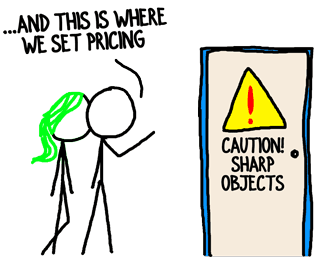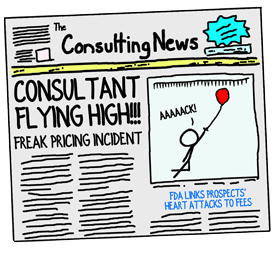Correctly pricing your consulting firm’s projects is like positioning a balloon in an unlit room made of nails. I’m not sure why such a room would exist or how you would get the balloon in there, but go with me on this one.
On the pricing floor of the room are the rusty nails that cheapen your consulting firm, let the air out of your firm’s credibility or fit projects you can’t deliver profitably. But you’re probably more worried about the needle-sharp nails on the ceiling.

As your pricing balloon drifts higher, it imputes higher value and gives your consulting firm space to deliver client delight while maintaining a high margin.
But a millimeter too high and the balloon pops, making you scream in fright. Or maybe that scream was frustration over losing the project.
How do you position your balloon just a hair below the upper nails?
Through hard experience you may have determined that asking prospects about their budget doesn’t help. Prospects typically don’t shine any light on pricing constraints in response to the budget question.
However, your consulting firm should always test for fee tolerance.
You can accomplish this with one, simple question.
What fee for this work would strike you as so high that it would knock you off your chair? I’ve found causing clients a heart attack is bad for business!
That’s the Heart Attack Question.
And yes, you can literally use those words. Or, you can try a variation such as, “At what point would the fee for the project we’re discussing be outside the range of feasible for you?”
It’s worth tamping down your discomfort and learning to ask the Heart Attack Question for three reasons:
First, it’s phenomenally effective. Your consulting firm will gather critical information you need to win the project.
Second, the original version builds rapport because it’s a (grimly) funny way to talk about fees. Clients always laugh when you ask the Heart Attack Question.
Third, it raises the reference price. Let’s say your prospect offered no information when you asked for a budget, but silently she’s hoping your consulting project comes in below $75,000. After you cheekily pose the Heart Attack Question, your prospect laughs, thinks for a moment and chortles, “A heart attack? If this came back at six figures, probably my boss and I would both have heart attacks!”

In that brief moment of thinking, your client just told herself in a very real, visceral way, “I’ll be okay as long as the project fees are under $100,000.” And just like that, the pricing ceiling on your consulting project has lifted 30%!
While other consultants would have punctured their chances at $80,000, you can float a higher-value project with a $98,000 price tag and still win it.

If your prospect genuinely has no idea what a reasonable budget is, then you can lead with an absurdly high number. It sounds like this:
Client: A heart attack? Gosh. I just have no clue what a project like this should cost.
You: Well, I think we can both agree that $3 million would be a patently unreasonable number! (ha ha ha)
Client: (ha ha ha) Yes. That’s for sure.
You: So, we know $3 million is unreasonable. At what point does it become reasonable? One million? Five hundred thousand? Three hundred…?
Client: I still don’t know for sure… but I really don’t think I’d be happy paying over $150K for this.
You: Got it!
Consulting firms that incorporate the Heart Attack Question into their standard discovery process win more projects at higher fees.
What are your thoughts on adopting the Heart Attack Question for yourself and your consulting firm?
Text and images are © 2024 David A. Fields, all rights reserved.

 David A. Fields Consulting Group
David A. Fields Consulting Group 

Love this approach and have used it effectively over the years based on training sessions with David…a good reminder! Jealous of the 70 degree weather, 20s in Boston.
I like the heart attack question, has a different perspective that connects. In these situations, I’ve asked the client at what price point is it not worth solving the problem which helps focus on their idea of budget and helps frame the conversation around what the problem is costing them too which has helped me talk about window of time (don’t extend the conversation since each day costs “X”…).
Sounds like the pricing discussion needs to happen after the value proposition is very clear to the customer.
It sounds like the pricing discussion needs to happen after the value proposition is very clear to the customer.
I like the concept but since I often work with healthcare executives, I’ll look for a different metaphor.